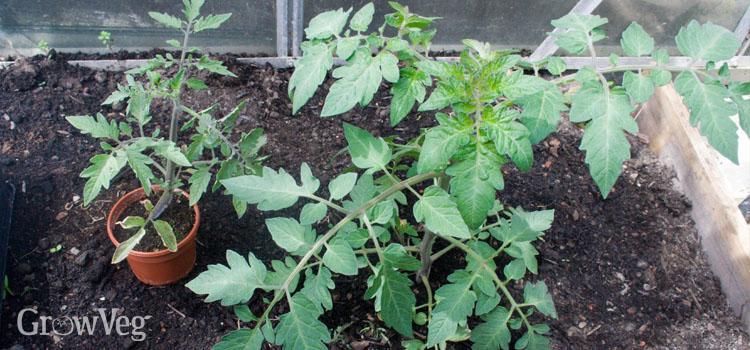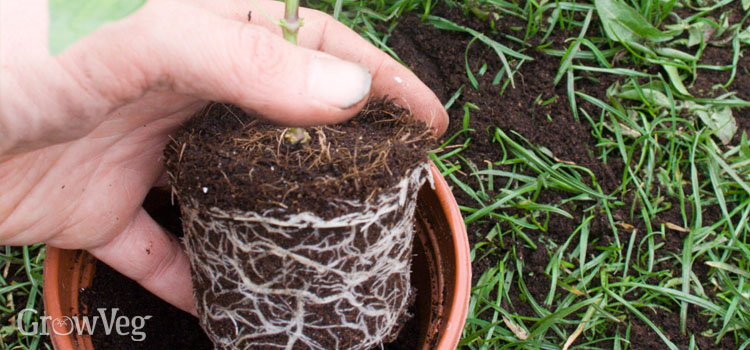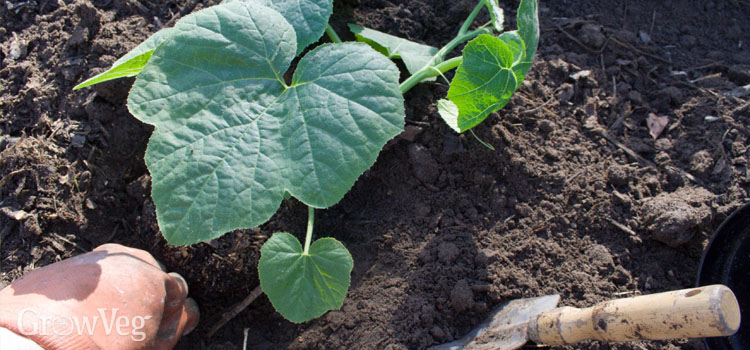Most gardeners have to learn the hard way about the best time to plant out seedlings they have raised indoors or in a greenhouse. In the first year some of their plants will be a success while others will keel over and die for no apparent reason and it can take several seasons with all their weather variations before it becomes apparent why they failed. It’s a pity because a little good advice can save a lot of disappointment and significantly increase the levels of success in the garden. With this in mind here’s my guide to deciding when pot-raised plants should leave home and settle down in your vegetable beds.
To illustrate the problem take a look at the picture below which shows two tomato plants from my own greenhouse this year. Both were started at the same time, raised in identical conditions from the same seed packet using the same potting compost. The plant on the right was transferred to the greenhouse vegetable bed at an optimal time whereas the one on the left was kept in a pot too long (I often end up raising more plants than I have room for!) In just over three weeks the difference in growth and plant health is clear. Getting plants out into the main vegetable bed is essential for good growth! However, transfer them too early and you risk them being damaged by late frosts or setting their progress back with adverse weather conditions.
You are watching: The Perfect Time to Plant Out Seedlings and Young Plants

Signs That it’s Time to Plant Out
Raising plants in pots or seed trays is a bit like giving them life support. Intensive care is necessary to ensure that things that are usually available naturally in the garden (light, water, nutrients) are supplied in the correct quantities. Light often needs to be supplemented to prevent ‘leggy’ growth, watering needs to be daily and even good quality seed-starting potting soil will only have limited supplies of nutrients that eventually need replenishing.
That’s why it’s important to watch for these signs to determine when plants are ready to move:
- Size: Once the plant has grown wider and about twice as tall as the pot it will be struggling to get enough water. You may notice that the soil is drying out more quickly because the plant is taking up the water faster and more moisture will be lost through the larger leaves, particularly if it’s under grow lights.
- Soil: After about 8 weeks the plant will have used most of the nutrients in the small pot and growth may slow down.
- Roots: Holding the plant upside down with the stem between your fingers you can remove the plant pot and examine the roots. If they are starting to go round and round the edge of the pot then the plant is in danger of becoming ‘pot-bound’ and needs more space.
- Leaves: Keep an eye on the plant and note if any leaves start to lose the normal vigorous green colour, curl or droop. Yellowing leaves indicate severe nutrient deficiency and ideally you want to transfer the plant well before this stage.

As soon as one of these signs is noted it’s time to take action:
- Transfer the plant outside if conditions are suitable (see below) or
- Re-pot the plant in a larger pot with fresh potting soil to give it more nutrients, water and root space. This is a delaying tactic necessary if you can’t transfer the plant when it is ready.
External factors
Unfortunately the weather isn’t always in tune with when our carefully raised plants need to be transferred outside. These are the factors that need to be taken into consideration:
- Temperature range: Extremes of temperature are bad for plants that have been used to the careful regulation of light, heat and water. Therefore the best time to transfer plants is not on bright sunny days when the clear skies usually cause the night-time temperature to plummet. It’s better to pick dull overcast days when the temperature range is smaller.
- Wind and exposure: Plants raised indoors or under cover won’t have ‘toughened up’ to the air movements outside. Avoid breezy days and exposed areas or put up wind breaks around the plants (as long as they don’t shade them). This year I lost several beans because the wind picked up as I planted them out and the large leaves twisted off the plants in the wind.
- Waterlogged, heavy soil: It’s important to delay planting out if the ground is waterlogged, particularly important on clay soils, as this deprives roots of the air they need and can keep the soil temperature too low.
- Pests and predators: Early spring often brings many young birds eager for food and they love the tops of pea and brassica seedlings so be aware of this and protect plants if necessary. Likewise, sudden increases of pest numbers such as aphids are often seen in late spring and early summer.
- Personal attention: It’s never a good idea to transfer plants when you are just about to go away for a few days. Much better is to choose a time when you will be around to keep an eye on their water levels and whether any pests start to attack them.
I find it’s a good idea to raise more plants than I have room for in the garden and hold some back when planting out. This ensures that if a late frost or unexpected pests damage the plants, I haven’t lost my whole crop. However, it’s important to avoid the mistake of cramming these extra plants into the garden, overcrowding the others!
Transplanting Young Plants
Read more : Pile Height & Grass | Guide | Artificial Lawn Company
As your plants become ready to make the move outside it is important to get them used to outside temperatures. Over a period of a few days take them outside so they are exposed to the temperature variations and air movements – for details see our article on Hardening Off plants. Take note of the weather forecast to determine the best days for planting out.

Young plants are particularly vulnerable to being eaten so protect from birds if necessary or cover with garden fleece to keep flying insects away. If slugs are a problem, it’s best to put out beer traps a few days before as one slug can munch through a whole row of precious young plants in a night.
When planting out, firm the soil around them and water them well to ensure that the roots are kept moist. Keep a close eye on them in the following days to catch any problems before they develop. When plants are transplanted growth will usually be set back by 1 – 2 weeks as the roots establish themselves after which they will quickly catch up.
Please do add your own tips for helping plants to transfer well to outdoors by adding a comment below…
Source: https://gardencourte.com
Categories: Garden news

